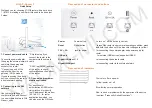
PMP 450 Planning Guide
Glossary
Term
Definition
inerrors count Field
How many inbound packets contained errors that prevented their delivery to a higher-
layer protocol.
innucastpkts count
Field
How many inbound non-unicast (subnetwork-broadcast or subnetwork-multicast)
packets were delivered to a higher-layer protocol.
inoctets count Field
How many octets were received on the interface, including those that deliver framing
information.
Intel
A registered trademark of Intel Corporation.
inucastpkts count
Field
How many inbound subnetwork-unicast packets were delivered to a higher-layer
protocol.
inunknownprotos
count Field
How many inbound packets were discarded because of an unknown or unsupported
protocol.
IP
Internet Protocol defined in RFC 791. The Network Layer in the TCP/IP protocol
stack. This protocol is applied to addressing, routing, and delivering, and re-assembling
data packets into the Data Link layer of the protocol stack. See
http://www.faqs.org/rfcs/rfc791.html
IP Address
32-bit binary number that identifies a network element by both network and host. See
also Subnet Mask.
IPv4
Traditional version of Internet Protocol, which defines 32-bit fields for data
transmission.
ISM
Industrial, Scientific, and Medical Equipment radio frequency band, in the 900-MHz,
2.4-GHz, and 5.8-GHz ranges.
L2TP over IPSec
Level 2 Tunneling Protocol over IP Security. One of several virtual private network
(VPN) implementation schemes. Regardless of whether Subscriber Modules have the
Network Address Translation feature (NAT) enabled, they support VPNs that are based
on this protocol.
Late Collision Field
This field displays how many late collisions occurred on the Ethernet controller. A
normal collision occurs during the first 512 bits of the frame transmission. A collision
that occurs after the first 512 bits is considered a late collision. A late collision is a
serious network problem because the frame being transmitted is discarded. A late
collision is most commonly caused by a mismatch between duplex configurations at
the ends of a link segment.
Latency Tolerance
Acceptable tolerance for delay in the transfer of data to and from a module.
Line of Sight
Wireless path (not simply visual path) direct from module to module. The path that
results provides both ideal aim and an ideal Fresnel zone.
LNK/5
Furthest left LED in the module. In the operating mode, this LED is continuously lit
when the Ethernet link is present. In the aiming mode for a Subscriber Module, this
LED is part of a bar graph that indicates the quality of the RF link.
VI
pmp-0047 (March 2014)
Summary of Contents for PMP 450
Page 1: ...Cambium PMP 450 Planning Guide System Release 13 1 ...
Page 13: ...PMP 450 Planning Guide pmp 0047 March 2014 1 3 ...
Page 42: ...PMP 450 Planning Guide Figure 14 Custom Frequency tab of the SM 1 32 pmp 0047 March 2014 ...
Page 58: ...PMP 450 Planning Guide Figure 16 AP web based management screenshot 1 48 pmp 0047 March 2014 ...
Page 82: ...PMP 450 Planning Guide 1 72 pmp 0047 March 2014 ...
Page 155: ...PMP 450 Planning Guide pmp 0047 March 2014 1 145 ...






































